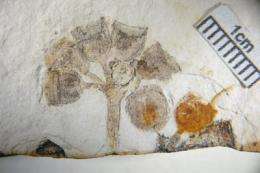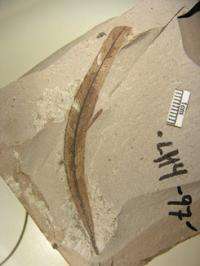Oldest known Eucalyptus fossils found in South America

(PhysOrg.com) -- Fossils of leaves, flowers, fruits and buds found in Patagonia, Argentina, have been identified as Eucalyptus and date to 51.9 million years ago, making them the oldest scientifically validated Eucalyptus macrofossils and the only ones conclusively identified as naturally occurring outside of Australasia.
A Cornell-led team of researchers, reporting in the June 28 issue of the online journal Public Library of Science One, identified the fossils as belonging to a Eucalyptus subgenus, Symphyomyrtus, which also makes that subgenus older than previously thought.
The researchers identified a suite of structures characteristic to the genus Eucalyptus in the morphology (shape) of imprints found in separate fossils. Some key characteristics included long, thin leaves with smooth edges, dots on the leaves that reveal oil glands, and scars on the fruits from where petals and sepals fall off.
The evolutionary history of Eucalyptus and its relatives has been poorly documented from the fossil record. In the past, a few researchers have claimed to identify Eucalyptus fossils from South America, but those records failed to hold up to modern scientific examination.

"The genus Eucalyptus is restricted to Australia and a few surrounding islands, and it is completely extinct in South America, which makes this discovery very significant not only for botanists and paleobotanists, but also for [its] biogeographical implications," said Maria A. Gandolfo, a senior research associate in the Department of Plant Biology and the paper's co-lead author. Although the Eucalyptus genus and the broader group of plants called eucalypts are native to or naturally occurring in Australasia, humans have transplanted them to other parts of the world.
The fossils were found at a site called Laguna del Hunco, northwestern Chubut Province in Patagonia. Although petroleum exploration geologists first discovered fossils at this site in 1932, a team of researchers from the United States and Argentina including Gandolfo and Elizabeth Hermsen, Ph.D. '05, a postdoctoral associate working in Gandolfo's lab, collected important fossils in 2009 that included fruits, branching structures that support the fruits, three flower buds and a flower.
"The buds provided important information that placed them within the genus Eucalyptus; they really helped clinch the identity of the fossils," said Hermsen, who was also a lead author on the paper.
The researchers also used a computer program and analysis of the morphology to create a phylogeny -- a branching diagram that depicts the evolutionary relatedness among groups of organisms (e.g., species, populations) -- of Eucalyptus. Because the researchers were able to accurately date the fossils and then place them in a phylogenetic context in relation to living plants, the findings may now be used as a reference point to test the results of recent molecular dating studies that have calculated the age of the eucalypts.
Provided by Cornell University














